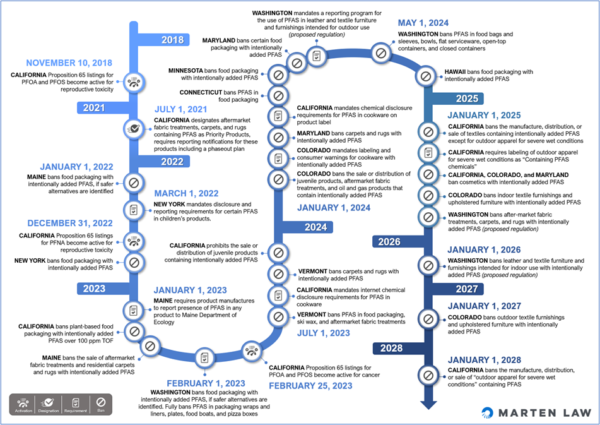There are 98 current PFAS policies in 20 states, and 104 adopted PFAS policies in 23 states.
The types of regulations are wide in scope. Most regulate the whole PFAS class rather than individual substances such as PFOA and PFOS, both which have been regulated for decades. This approach eliminates the common whack-a-mole scenario where a regulated chemical is simply replaced by a similar, unregulated chemical that may be just as hazardous. For example, when long chain PFAS first came under scrutiny, the chemical industry simply provided short chain PFAS as safer alternatives. They are not.
This is the 3rd post in my PFAS blog series. The first defined PFAS and explained why they are hazardous, and the second shared the types of products PFAS are used on, and common exposure routes.
U.S. regulations
The regulatory landscape in the U.S. is complex. In the absence of federal regulations, individual states regulate chemicals.
PFAS regulations can be loosely categorized as follows.
Product types. There are many product-type bills, including PFAS bans on food packaging and firefighting foam (11 states are regulating PFAS in both categories). Several states are addressing PFAS-treated textiles including carpets, rugs, home textiles and apparel. (CA Bill 1817, a sweeping bill that bans PFAS in textiles, with minor exceptions, is provided in more detail here.) Some of the other products and product categories include cosmetics and ski wax.
Vulnerable populations such as babies and workers. There are five adopted, and one pending bill, that target juveniles. Some of these bills are wider in scope because they target a list of prioritized chemicals and not just PFAS. However, California adopted bill AB 652 which bans PFAS from numerous juvenile products including booster seats, changing pads, infant carriers, nursing pillows and crib mattresses, starting in July 2023.
Mandate disclosure and reporting requirements. Last year, Maine passed bill LD 1503/HP 1113 that requires product manufactures to provide written notice regarding products that contain intentionally added PFAS. The notice must include a product description, the function of the PFAS in the product, the amount of PFAS in the product, and manufacturer contact information.
Drinking water limits. Many states are beginning to regulate PFAS in drinking water, given that so many public water supplies are contaminated. In addition, the Environmental Protection Agency (EPA) is proposing reporting and record keeping requirements for PFAS under the Toxic Substances Control Act (TSCA), which should be finalized this year.
PFAS regulations for 2023
 Several PFAS regulations will take effect over the next few years. Martin Law has provided an excellent overview of PFAS regulations between now and 2028.
Several PFAS regulations will take effect over the next few years. Martin Law has provided an excellent overview of PFAS regulations between now and 2028.
Throughout 2023, consumer product manufacturers, importers, and retailers of products containing PFAS must comply with many new regulations in California, Maine, Vermont, and Washington.
A summary of PFAS regulations by state is provided below:
California: Plant based food packaging with intentionally added PFAS over 100 ppm (total fluorine content) is banned. In July, California will mandate chemical disclosure of PFAS in cookware.
Maine: Product manufacturers must report PFAS presence to Maine Department of Ecology. Aftermarket fabric treatments and residential carpets and rugs with PFAS are now banned.
Washington: Will ban food packaging with PFAS in February.
Vermont: In July, Vermont will ban PFAS in ski wax, food packaging, aftermarket fabric treatments, carpets and rugs.
What does it mean for companies who manufacture or sell products?
Simply put, companies need to get a good grasp of what these PFAS regulations mean so that they can abide by them to avoid legal ramifications.
Regulations: Know the most up to date PFAS regulations. Make sure you understand them. This may include seeking legal advice or using sites such as Safer States, which has a PFAS bill tracker.
Supply chain: Know your supply chain. Getting the relevant information to meet these regulations will take lots of digging, developing solid relationships with your manufacturers and ensuring you know where your products are made. Sometimes, manufacturing is subcontracted to other suppliers. You are still liable, so know your supply chain.
Chemicals: Know your chemicals. If you know what chemicals are used on products, it will help you avoid using PFAS. At a minimum, find out why PFAS is added and if it is really needed. If so, ask yourself where is it added during manufacturing, and what safer alternatives exist?
Do you need help with your PFAS elimination strategy, chemical management or sustainability?
For help with sustainability, circularity and chemicals, contact Amanda Cattermole at (415) 412 8406 or Amanda@cattermoleconsulting.com. We can help you develop powerful solutions to protect your company and brand reputation.
Tips and Insights contains information to help you make informed sustainability decisions. Each post highlights a particular topic that you may want to consider for your business.

